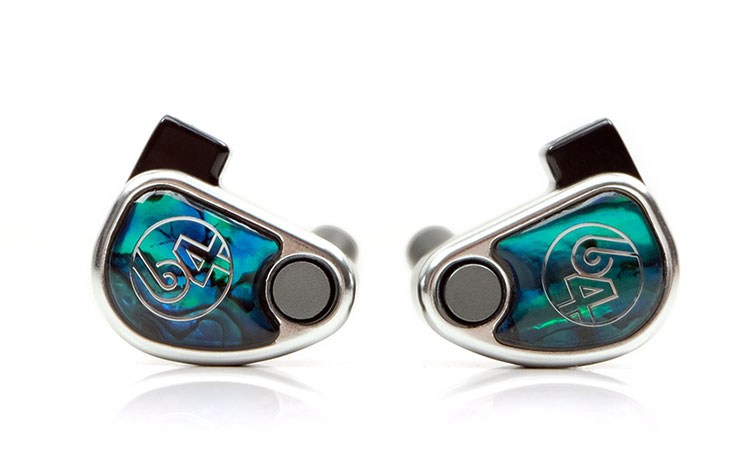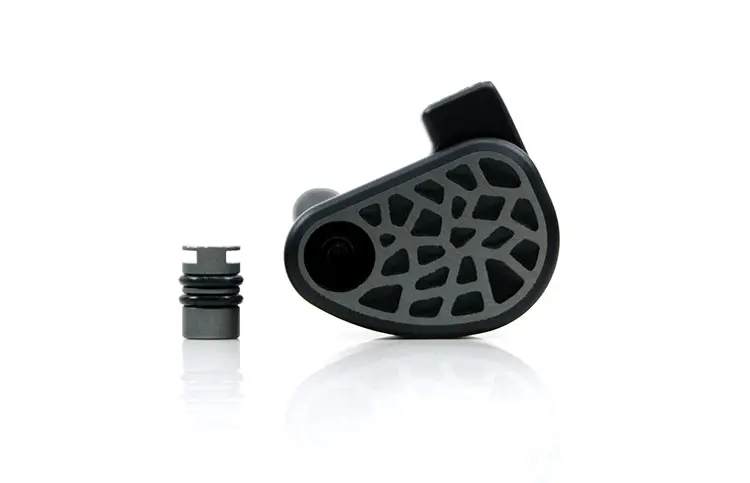Select Comparisons
The following performance comparisons to the Volür were compiled using the iBasso DX320 MAX Ti and the Luxury & Precision P6 Pro as my main sources. All compared IEMs were using the default m15 apex module and their stock Premium cables with SpinFit tips.
64 Audio Nio
The 64 Audio Nio was launched in 2020 with our review in that same year. The Nio is the legacy IEM upon which the Volür was based so there is a degree of overlap in some of the features.
Technical
From the Nio 9 driver count, we move to the Volür 10 driver with a single dynamic inside the older IEM and that upgraded dual 9mm dynamic driver in a true isobaric configuration in the newer.
Both use a tia High driver tubeless system. However, the Volür is further augmented with the implementation of the new tia Waveguide system which goes some way to address Nio owner feedback on the darker tone of the original version.
In all other aspects, the two models are similar and that includes their 7 additional BA drivers with 6 covering the mids and a single BA for the highs. The two IEMs also use the apex filter system combined with LID, (Linear Impedance Design), for output impedance matching.
The Nio is rated at 6Ω impedance but has a moderate level of efficiency for SPL at 105dB @1kHz 1mW. That theme continues for the Volür with a similar load at 6.3Ω but less efficient at 103 dB/mW @1kHz @1mW, presumably due to an additional dynamic driver in the configuration.
Design
The Abalone stays but the coloration of the plates and finishing on the shells have been changed. From a sea green tone, we now move to a darker bluish purple though both are organic materials so the emphasis is on individualism with no two plates ever being exactly the same.
The ditching of the chrome fenders and polished shells for a slimline chamfered frame on top of an anodized black CNC-machined aluminum shell brings the Volür up to pace with some of the new thinking from 64 Audio on their high-end models.
The form factor for both is a familiar sight with the trademark teardrop curvature on both IEMS capped by the lengthy 2-pin stem to the rear and apex filter venting at the base of the plate.
Just to note, the Nio review was completed before the m12 filter was launched, and officially it’s still not a filter supplied with the Nio if you purchase it today.
The stock cables are the exact same. Both the Volür and the Nio use the 26AWG 4-wire silver-plated OCC copper Premium cable. It handles well and is lightweight with an SE termination by default and low microphonics.
I think it’s fine for the Nio but I would have liked to have seen the Premium 8-Braid Cable with the Volür just to acknowledge the price jump between the two in a more concerted fashion.
Performance
If you are not an out-and-out basshead then the Volür is a clear step up technically and in terms of delivering a more accurate timbre. Perhaps that will surprise some people who think two dynamic drivers should have more volume than one but it works differently here.
The Volür drops a few dB sub-200Hz relative to the Nio’s elevated almost L-shaped low-end response but increases the dynamic impact and energy. You get less bloom and warmth and more thrust and snap with the Volür lows and some additional bass-to-mids separation which I always prefer
That change affects where you focus and attention sits with each IEM’s presentation. The Nio lows may pull your ear further down towards paying attention to the underlying rhythm of a track.
Whereas the Volür is more balanced and with some obvious tweaks in those midrange BA drivers, delivers a much more engaging midrange and vocal image as a result.
There does seem to be some additional 1-3k emphasis on the Volür which helps tease out the vocal presence and increase separation, much more so than the Nio which is comparatively relaxed over the same range.
Throw in a better treble performance from the Volür in terms of presence and coloration and suddenly the mids sound more accurate, revealing, and holographic in its imaging.
As a result, you get this livelier rendition across the Volür midrange and highs whereas the Nio, though smoother, has less engagement and thus a little flatter and darker in its delivery.
64 Audio Trio
The 64 Audio Trio was launched a year earlier than the Nio, initially as the tia Trio and then just the Trio. It sits one position below Volür in terms of pricing. It remains to this day one of my most used and referenced universal IEMs for work and play.
Technical
Although both the Trio and the Volür are hybrid IEMs and use 64 Audio’s apex and LID technology that is where the similarities kind of stop.
The Trio is as the name suggests, a single and slightly larger back-vented 10mm dynamic driver combined with two BA drivers, one of which is a tia High. The precise configuration is the dynamic driver for the lows and mids, the BA for the mid-highs, and the tia High for the ultra-highs.
On paper, the Volür dominates if we go by pure driver count with its True Isobaric dual 9mm dynamic driver setup for the lows, no less than 6 BA for the mids, a single BA for the mid-highs and also the tia High driver to top it all off.
However, the Trio’s ace card is the fact that it is entirely tubeless, whereas the Volür only applied tubeless to its tia High driver. That makes a huge difference in the performance for me despite the lower driver count.
Just to note that though both IEMs have the m15 apex filter by default, the Volür apex system is swappable with additional filters in the accessory line-up. The Trio’s m15 is internal and fixed so you will not see any filter sockets on its plate.
The sensitivity and load ratings of these two IEMs are similar at 5.5+0.5/-1.5 Ω impedance and 104 dB/mW @1kHz @1mW for the Trio and 6.3Ω for the Volür but ever so slightly less efficient at 103 dB/mW @1kHz @1mW.
Design
The Trio is perhaps one of the smaller and shallower form factors in the 64 Audio universal IEM line-up, at least at the high end of things. Side by side, the Volür looks a few millimeters deeper with a longer 2-pin connector stem at the rear also giving it a larger appearance.
The relative comfort of both IEM is quite close with the Trio perhaps a little flusher to the ear than the Volür but otherwise, both are tip dependent, and since my Trio review, the tip selection has been revised to match what now comes with the Volür.
As mentioned, you will find no apex filter swapping option since this is fixed internally on the Trio to m15. You can thus maximize the isolation a bit more on the Volür with the m20 module.
Aesthetics on the Trio are low-key, perhaps even arguably a bit dated by today’s standards with that black and greyish executive look and tia graphic on the side of the left driver.
The Volür’s more exotic Abalone blue and purple combined with the more harmonious anodized black frame and shell body has more of a modern vibe and better visual ‘pop’.
Cables choices are all up to speed with both receiving the latest Premium 26AWG 4-wire silver-plated OCC copper cable. If you go back to my review of the Trio you will notice that in 2019, the Trio came with a similar SPC wire but the finishing was stringier and more DIY-looking.
Performance
Two very contrasting performances for me here with the Volür offering a deeper and better-defined sub-bass response, more upper-bass and lower-mids warmth and presence, and a balanced and slightly smoother treble tone.
The Trio has some incredible imaging width and some dazzling highs, delivering more sparkle and contrast on its timbre, and also emphasizing its 2-3k a bit more.
You get some lovely impact on the lows, some strong vocal performances, and plenty of upper treble energy making it more of a roller coaster of a sound signature and not quite as evenly balanced as the Volür tuning.
I tend to use foam tips to soften up the Trio delivery because of that upper treble energy. If you switch to SpinFit or the wide-bore alternative silicone tips you will get a wall of evanescent sparkle coloring a lot of the Trio timbre.
For some, this might be too much which is where the Volür’s more controlled treble tuning will work better. You still get some nice headroom and good energy but it’s more blended and not as peaky around the 8-10k range.
The enhanced warmth from the mid-bass and lower-mids also helps give the Volür’s mids a bit more body and substance compared to the Trio, which, though quite forward has a slightly hollower quality and less 4-5k presence.
64 Audio U18s
The 64 Audio U18s was launched in mid-2021 without review shortly after. This is a highly-rated IEM for us but one with a bit more of a pro-audio pitch, particularly for the stage crew. It is positioned one step above the Volür in the 64 Audio universal monitor line-up.
Technical
The U18s stands out from the other two comparisons courtesy of a much higher driver count, lacking the Volür’s hybrid driver blending though both use a passive 4-way crossover.
This is an 18-driver monitor with an all-BA design consisting of 8 drivers for the lows, 8 for the mids, and 1 for the mid-highs, with both monitors using a tia driver for the highs. This one is firmly in the balanced armature fan zone.
Both monitors do share some key technology highlights, namely swappable apex filters and LID, (Linear Impedance Design). Just to note, our U18s review was done before the launch of the m12 apex module and currently, the 64 audio website does not show any inclusion of the m12 for the U18s.
The U18s is rated at a slightly higher 8Ω level but more efficient at 106 dB/mW @1kHz @1mW compared to the Volür’s 6.2Ω impedance and 103 dB/mW @1kHz @1mW benchmark. There is not a huge difference using the iBasso DX320 MAX Ti on gain stage 2 but if anything, I actually found the U18s marginally less sensitive when volume matched.
Design
The U18s faithfully adheres to the 64 Audio universal format design language which means both it and the Volür have similar shaping though the U18s is the bigger of the two monitors in terms of shell depth.
With almost the same choice of filters and tips, both IEMs offer a very similar fitting experience though the U18s is non-vented. Being an all-BA IEM, it does not require venting which is a hallmark of hybrid monitors that use dynamic drivers.
If the fitting and apex filters are equal in both with similar tips, the U18s should isolate marginally better because of the lack of venting. That being said, I felt the Volür competed quite well for general isolation levels.
Aesthetically, the U18s has a very intricate design though perhaps not as much immediacy as the purple/blue of the Volür’s Abalone plates. Still, the lattice-like geo-rock design is complex and very interesting, making the U18s one of the standouts in the line-up alongside the Nio and the Volür.
Both cables are 3.5mm SE by default but here is where the U18s is a step up on paper with its inclusion of the more expensive 8-Braid Silver Cable, (OCC SPC rather than pure silver), as opposed to the Volür which uses the 4-Braid silver-plated OCC copper cable.
Performance
Pick the Volür if you want a slightly smoother sound, more bottom weight, and enhanced power. Pick the U18s if you want maximum staging width, a more vibrant and articulate midrange, with slightly more headroom.
Of the two, the Volür sounds a little more saturated courtesy of that true isobaric dynamic driver delivery. When it hits, it really outclasses the punchy but much lighter-sounding BA woofers inside the U18s.
For me, that stronger fundamental from the Volür changes the direction and your focus when listening to these two IEMs in a completely different way.
Yes, neither of them is particularly shouty in the mids, with the U18s offering a bit more lower-mid presence. There is some nice balance from 2-4k here for both with a more modern slightly south of the Harman Target tuning.
However, acoustics are different on the U18s which offers more mid-imaging complexity and space so when spatial cues way out wide hit you really hear them with more forcefulness whereas the Volür is somewhat softer and thinned out in similar areas.
As such, you can perceive the staging of the Volür to be much deeper, but slightly narrower through the mids and more attenuated through the upper treble, a point where the U18s just slightly edges ahead in presence.
It does give it a smoother tone though I do not really find the U18s to be that dry, rather it doesn’t convey the same lower-harmonic order bias so notes carry less richness or body.
Our Verdict
The 64 Audio Volür has some of the ‘tastiest’ lows to date in the company’s universal monitor line-up and provides a clear upgrade path for Nio fans who crave a bump in tonal clarity and technical proficiency.
It also carves out its own very distinct niche for those who crave power but are unwilling to give up a balanced smooth sound throughout the range at the same time.
What I like most is the flexibility the Volür offers in pairing with DAPs or sources. Yes, they bring a flavor but not a single one of them sounded horrible or underpowered. This is a tuning that really does have a lot of glaring weaknesses.
I dig the new design, the updated Abalone plates combined with the new black shell look stealthier and more modern than the Nio design. I do wish the 8-Braid Premium cable in 4.4mm came as a default choice rather than the standard 4-wire Premium cable SE though.
Overall, a very source-friendly, lively, and powerful-sounding IEM with excellent dynamics packed with plenty of sound shaping tips and apex filters to appeal to a wide range of high-rollers.
64 Audio Volür Technical Specifications
- 2 Low DD – 6 Mid BA – 1 High-Mid BA – 1 tia High BA
- 5hz – 22kHz Frequency Response
- 103 dB/mW @1kHz @1mW (94mV)
- Integrated 4-way Passive Crossover
- 6.3Ω Impedance @1kHz
- Apex Technology Isolation: -20dB, -15dB, *-12dB, -10dB





